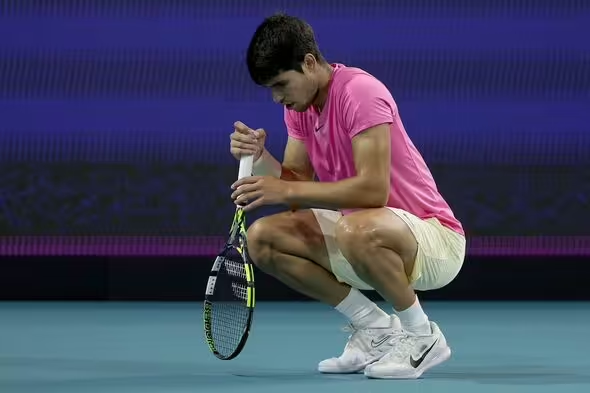Illustration Credit: Getty Images
The tennis wunderkind started by beating everyone – so why does he keep getting beaten?
Vikram Nijhawan, Contributor
When then-18-year-old Carlos Alcaraz Garfia arrived at the U.S. Open in 2021, close followers of the sport knew he was a rising prospect. It was his first time playing at the year-end Grand Slam, and Alcaraz – then ranked World No. 55 – proved those lofty expectations true by upsetting World No. 3 Stefanos Tsitsipas.
It was the biggest win of the young star’s career and allowed him to advance to the quarterfinals. This would be a career-high moment for any young player, but one that Alcaraz easily topped the following year, when he won the U.S. Open for his maiden Grand Slam title, becoming the youngest men’s World No. 1 in the sport’s history.
It spelled the beginning of an all-time great career, which two years later has continued to trend upward, but for some head-scratching lulls in form, all the more anomalous because of his overall remarkable achievements. In the wake of a three-match losing streak starting this summer, leading to a blowout defeat at the U.S. Open to the unseeded, one-time quarterfinalist, Botic van de Zandschulp, it’s safe to say Alcaraz finds himself in another such slump at the tail-end of 2024.
His latest loss is a blight on an otherwise highly successful season, which saw the Spaniard win the elusive ‘Channel Slam’ – winning the French Open and Wimbledon back-to-back – and finish runner-up at the Paris Olympics. But since arriving at the North American summer hardcourts, Alcaraz hasn’t been the same player – and it’s not the first time in his precocious career that this has happened to him.
Last year, after winning Wimbledon, and ending the grass-court reign of men’s tennis G.O.A.T. Novak Djokovic, Alcaraz looked unstoppable. But then he went eight months without winning a title, and during that stretch, only advanced to one tournament final. The young star had in a sense become a victim of his success: his comparative late-season lows merely magnified by his earlier highs.
With Alcaraz, the explanation for his inconsistency lies somewhere between the qualitative and the quantitative. His incredibly bold approach, always looking to hit winners and play aggressively, has led to spectacular wins. But as stats have shown, when he’s suffered defeats, it’s been by wide margins on the decisive metrics. In his most recent U.S. Open loss to van de Zandschulp, for instance, he made a stunning 34 unforced errors compared to only 17 winners. While his ceiling of potential is about the highest one could ever achieve on a tennis court, Alcaraz’s floor, to quote YouTube tennis pundit Gill Gross, is “unnecessarily erratic, wasteful, and error-filled.”
Beyond tactics, Alcaraz’s full-blooded intensity has also cost him. Like his legendary country-man Rafael Nadal, the younger star’s willingness to grind out every point ends up winning him plenty; but over the long run, he’s paid his dues with depleted stamina, resulting in frequent season-interrupting injuries. For all his relentless energy, it shows the 21-year-old isn’t indefatigable – neither physically, nor mentally.
When Djokovic edged past Alcaraz in an extremely narrow final at the Cincinnati Open last August, it left a mark on the latter for long after. He looked similarly frazzled at this year’s Cincinnati tournament – crashing out of his opening match, and smashing his racquet, in a first for the young model for good sportsmanship. This was just after a soul-crushing loss to Djokovic at the Olympics, in the match that cost him a gold medal.
It’s not difficult to conceive that this dispiriting loss could lead to another lackluster patch ahead for Alcaraz. He’s a player who rides on momentum, and without it, he will likely struggle to maintain his dominance.
All this stands in contrast to his emerging rival, Jannik Sinner, whose rock-solid game and ability to roll off setbacks (including the controversy around a recent positive doping test) have allowed him to perform well consistently throughout 2024. Even without playing his A-game, the young Italian still won this year’s U.S. Open title without much trouble, never being pushed into a five-set match.
Sinner and Alcaraz have split the year’s four Grand Slams between themselves and will surely compete as the two top contenders in all the rest for years to come. Both have proven to be preternatural talents; but while Alcaraz currently has an 81% winning record for the year, Sinner’s is at 91%, with only five losses, and none of them before a quarter final.
Sinner’s metronomic strokes may evoke fewer fireworks than his younger Spanish peer, but for all the flair that Carlos Alcaraz brings to the court, he may soon realize that style alone won’t guarantee fans root for him, nor for the results he wants.




